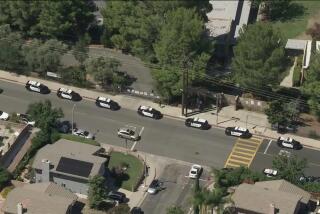Schools Testing Threat Analysis
- Share via
First comes the threat: a student talks of hurting others or him- or herself. The next step, assessing how serious that threat is, can be as random and varied as each individual alarm.
Educators and security experts collaborating on a pilot computer program being tested in 25 schools across America, including two in Placentia-Yorba Linda Unified School District, hope to bring order and method to such alarms.
Mosaic 2000, a program developed by security expert and author Gavin de Becker, is designed to analyze danger factors in a student threat and suggest a course of action.
If standard indicators of a severely disturbed child show up--cruelty to animals, for example, or a fascination with fire--parents would be alerted immediately, said Sharon Cordes, director of technology for the Placentia-Yorba Linda district.
Mosaic systems are currently at Yale, Penn State, Boston University and 25 other universities. In addition, a Mosaic program that analyzes domestic violence is used by some law enforcement agencies. After the field tests at schools and input from educators, the program ultimately might be made widely available to schools.
Placentia-Yorba Linda became a test site for Mosaic 2000 after Cordes, a former elementary school principal, wrote to De Becker in the wake of the Columbine High School shooting in Littleton, Colo.
The specter of large-scale violence at school commanded national and local attention in the past week as home videos of the Columbine shooters showed them planning their April assault.
Also, at Ladera Vista Junior High School in Fullerton, a 14-year-old boy who told police he was influenced by the Columbine incident was arrested after he allegedly asked some classmates to help him obtain guns and shoot other students.
A search of the youth’s home revealed no weapons, but police and school authorities are treating the threats seriously. The boy is in custody at juvenile hall and is scheduled for a court hearing next month.
“Mosaic takes the kind of situation that happened at Ladera Vista and helps make sure you’re not missing anything,” Cordes said. Some civil libertarians have raised concerns that the program might be used to predetermine troubled students. But Cordes said Mosaic is designed for use only after a threat has surfaced. Then it helps educators decide the threat’s seriousness and suggests a course of action.
By Mosaic standards, the potential for danger doesn’t lie in the specifics of the threat itself. For example, one student threatens to kill a friend, while another student threatens to blow up an auditorium full of people.
One outcome would be far more serious than the other, but “the relevance of the threat as a symptom is exactly the same,” said De Becker.
Mosaic asks 42 questions and determines a range of risks embedded in the answers. After the assessment is completed, the computer automatically deletes it, Cordes said.
“People have worried that the information could go into some national database or something,” she said, “but that’s not going to happen.”
But the program helps educators look for signs after a threat that the student might need immediate help--or might need to be removed from the school.
“People don’t just snap,” Cordes said. “There are lots of little indicators. But these boys doing this sort of thing are not monsters. When we’re assessing threats we always remember that it’s the situation, not that this person or child is a bad kid.”
More to Read
Sign up for Essential California
The most important California stories and recommendations in your inbox every morning.
You may occasionally receive promotional content from the Los Angeles Times.










